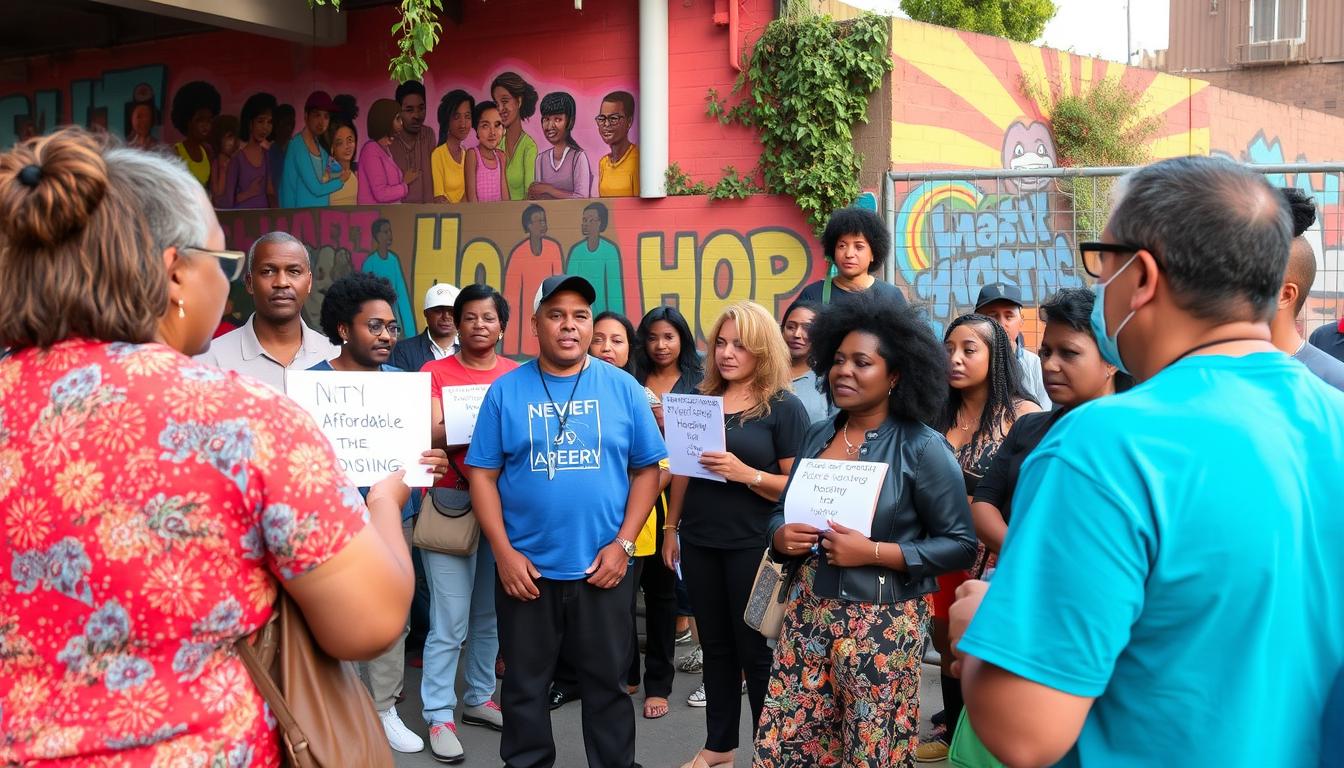Did you know over 700 units of affordable housing have been built by the Concerned Citizens of South Central Los Angeles (CCSCLA)? This shows our strong commitment to helping our community in South Central LA. This area is mostly made up of minorities and low-income families, with about 200,000 people living there.
We work hard as a Los Angeles nonprofit to provide affordable homes. We help families who make 35%, 50%, and 60% of the area's median income. Our homes come in different sizes, from 1 to 5 bedrooms, and some have up to 1,600 square feet.
Our homes offer more than just a place to live. They have central air and heat, sundecks, courtyards, play areas, recycling programs, and tenant associations. We also focus on helping the community by creating jobs on our projects. This gives local people valuable job training and referrals.
In a world where affordable housing is hard to find, we want to make a difference. We aim to improve our community through these efforts. At the same time, we fight against the threat of displacement.
Key Takeaways
- Over 700 units of affordable housing developed by CCSCLA.
- Housing options cater to families at various income levels.
- Units range from 1 to 5 bedrooms, with ample living spaces.
- Community-focused services include job training and referrals.
- CCSCLA's developments emphasize quality amenities and tenant support.
Understanding the Mission of CCSCLA
Concerned Citizens of South Central Los Angeles (CCSCLA) is all about social justice, economic growth, and protecting our environment. We are a community-based nonprofit. Our goal is to empower local people to tackle the challenges they face.
We believe that the best solutions come from within the community. This way, residents can speak up for themselves and fight against big issues together.
We work hard to make sure everyone has affordable housing, better public health, and environmental justice. Our projects are designed to listen to and include the voices of our community. By teaming up with community members, CCSCLA shows what it means to be a true nonprofit in Los Angeles.
To find out more about CCSCLA's mission and our efforts to make a difference, check out our About Us page. Let's work together to build a better future for our community.
History of Concerned Citizens of South Central Los Angeles
In 1985, we saw a big need to protect our community's health and well-being. This black-owned nonprofit was started to fight against a waste incinerator in our area. Since then, we've grown into a key group focused on housing and environmental issues in South Central Los Angeles.
The start of nonprofits in Los Angeles came from community needs, like housing crises during big migration times. By the mid-20th century, Los Angeles welcomed many African Americans, especially during World War II. Jobs in the aerospace industry drew them to the area.
Over the years, we've worked together to solve big problems. We've organized block clubs and empowered our community. Our work has led to many victories, making us a strong voice for affordable housing and justice. Our history shows our dedication to community growth and our people's strength in tough times.
The Role of a Los Angeles Nonprofit in Housing Developments
In Los Angeles, nonprofits are key in solving the housing crisis. California lacks nearly one million homes for low-income families. Our work focuses on creating affordable homes for those in need.
Affordable Housing Initiatives
We offer more than just a place to live. Our projects, like Roberta Stephens Villas, are a national example. They help fight the issue of renters spending too much on rent.
Over 9.2 million renters spend more than 30% of their income on rent. Our goal is to make housing more affordable and stable for everyone.
Community Employed Construction Programs
We also run construction programs for the community. These jobs help locals from South Central LA get involved. It boosts their skills and helps the local economy.
By focusing on community needs, we make a bigger impact. This way, we can invest more in our mission and community.
Learn more about the value of equity and investment in nonprofits here.
Impact on the South Central Community
We work hard to help people in South Central LA. Our programs give them skills for better jobs. This helps them live better lives and escape poverty.
Social and Economic Empowerment
We offer many ways to grow personally, like:
- Skill-building workshops that enhance employability.
- Mentoring opportunities connecting youths with professionals in their fields of interest.
- Community events that promote engagement and networking.
Our work makes a big difference. People feel more confident and secure. We serve over 1,000 members every year, showing our dedication to the community.
Environmental Justice Through Housing
We focus on making the environment better. We add green features to homes to fight pollution and poor living conditions. This improves health and quality of life.
We got $40 million to make the area better. We're fixing sidewalks and planting trees. These changes make the community safer and prettier. We work with A Place Called Home to help more people.
Community-Based Programs Offered by CCSCLA
Concerned Citizens of South Central Los Angeles (CCSCLA) is proud to offer many community-based programs. These programs help with education and youth development. They also address important social issues.
Our educational programs focus on building skills and personal growth. Every year, over 3,000 kids from South Central join our youth programs. They learn and grow through activities that help them become leaders.
These programs are a safe space for young people to thrive. They help kids reach their highest potential.
- Workshops focused on academic improvement
- Skills training tailored to industry needs
- Recreational activities promoting physical health
We know how important nonprofit organizations are in Los Angeles. They help build strong communities. Our programs teach kids the value of teamwork and belonging.
By working together, we inspire the youth of South Central LA. Our efforts create jobs for over 300 residents. This helps the local economy grow.
CCSCLA is dedicated to improving the lives of our community members. We work on projects like environmental sustainability and cleanliness campaigns. Our work shows the power of community-based programs in making a difference in South Central Los Angeles.
Success Stories of Affordable Housing Projects
We are dedicated to making housing affordable in Los Angeles. The Roberta Stephens Villas is a great example. It shows how housing and support services can change lives. It gives people a place to live and helps them connect with their community.

Roberta Stephens Villas as a Model
The Roberta Stephens Villas is a success story in affordable housing. It offers support like case management and health care. Many residents have overcome tough times and found stability here.
CCSCLA shares many success stories. People have changed their lives after moving here. Affordable housing is key to their success.
Expansion into Various Neighborhoods
We're working hard to solve the housing crisis. We're expanding into new neighborhoods. This shows our commitment to fair development.
We want to help low-income families all over Los Angeles. Our goal is to create supportive environments like Roberta Stephens Villas. This way, everyone in the community can do well.
We believe in sharing these success stories. We hope they inspire more positive changes in Los Angeles. For more stories, visit success stories in Los Angeles.
Challenges Facing Housing Initiatives in South Central LA
In our ongoing efforts to address the challenges in housing initiatives in South Central Los Angeles, we face big hurdles. About 500,000 very low-income households in Los Angeles County lack housing. This number grows to around 700,000 when we look at low-income households. These figures highlight the urgent need for affordable housing in Los Angeles.
Our nonprofit and charities in Los Angeles work hard to find solutions. But, money is a big problem. The cost of building materials, like lumber, has doubled. This makes it hard for us to keep going. Also, people in the community sometimes don't want new buildings. And, getting approval for projects can take a long time.
The need for affordable housing is always higher than what we can offer. This makes it hard for us to meet the needs of our residents. Looking ahead, we need new ideas and to keep working with the community. This will help us provide housing for those who really need it.
Getting Involved with CCSCLA Activities
We invite you to join us in the mission of Concerned Citizens of South Central Los Angeles (CCSCLA). There are many ways to volunteer with CCSCLA. Together, we can make a difference in our neighborhoods and build stronger community bonds. By participating, you'll feel a sense of belonging and purpose.
Volunteer Opportunities
Volunteering with CCSCLA lets you directly help with important projects. You can help in many ways, such as:
- Supporting housing projects through hands-on work
- Participating in community events that promote awareness
- Offering administrative assistance to streamline operations
- Engaging in outreach programs to connect with residents
Funding and Donations
Donations are crucial for nonprofits like CCSCLA to keep our programs running. Every contribution, big or small, helps us provide affordable housing and fight for social justice. We encourage you to donate and support our efforts to make a real difference.
Current and Future Housing Projects
Concerned Citizens of South Central Los Angeles is working on several housing projects. Our Affordable Housing Initiative (AHI) has raised over $50 million. This has helped create 1,011 affordable housing units in Los Angeles County.
We partner with development firms led by underrepresented groups. This approach promotes diversity and meets the unique needs of our neighborhoods.
We plan to invest in over 60 rent-restricted developments in the next three years. This will provide housing for more than 2,000 low-income residents. Our goal is to reduce costs and construction times.
We aim to use innovative designs that are sustainable. This way, we can offer affordable and environmentally friendly housing.
Our vision is to create dense, walkable neighborhoods. We believe housing is a fundamental human right. We're working to address homelessness by increasing housing supply.
We're committed to racial and economic justice. Our goal is to ensure everyone has access to healthy and vibrant communities.






